Gnomonics: an anchient science, or forgotten magic?

Stones on the photo are considered to be prehistoric sundials aged from 10000 to 4000 BC. Such sundials may be used in some rituals for determining local noon time and solstices. More details about this artefact can be found on BBC site. Wheather scholar"s guess is right or not, one can really learn a lot about our world with the help of simple vertical stick.
Long time ago, when hurring was not a usual human's state, some of our ancestors studied a lot about Universe with the help of vertically set stick and its shadow. In Greek such indicator was called gnomon, so gnomonics was the name for such studies.
While prehistoric sundials mentioned at the beginning is just a guess, the existense of instruments based on vertical gnomon can be historicaly proved. Watch's hand and its clockwise movement is just a 2D presentation of vertical gnomon's shadow during the day. First mechanical watches had only one hour hand and the analogy was even more obvious.
With vertical gnomon you can...

The first and most important knowledge, we can get from vertical gnomon, is orientation regarding cardinal directions. Thus, any obelisk (like the one which was moved to Paris from Egypt) has a gnomon in its origin. Sometimes there are concentric cyrcles around the base of the gnomon, which helps to determine North-Soth direction, as it is shown below. There are a lot of vertical gnomons all other the world, one may have a look at seasonal and directional markings on St.Peter's square in Vatican, for example.
... know cardinals
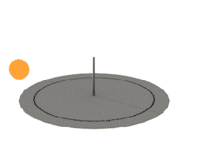
True noon is a moment of local Sun's culmination.
It happens when Sun crosses meridian plane of the observer - "meridian pass",
as astronomers use to name it. This moment can be observed with gnomon, in case we know cardinal directions.
As gnomon's shadow is decreasing before noon and getting longer after that,
the tip of the shadow is crossing the same cyrcle twice a day, if you are lucky with Sun and your time.
Bisector of angle gives south direction in north hemisphere.
... know the duration of Sun year and Moon month
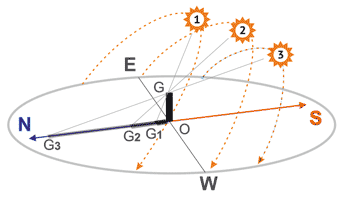
Assuming our primitive observer knew nothing about annual Earth's movement around the Sun, he could nonetheless notice that the length of gnomon's shadow at noon varies within some period which we call a year. Watching gnomon at noon every day, it is possible to mark shadow at the hightest and the lowest Sun position at noon. The days when Sun reaches such extremal heights are known as solstice days. On the draft they are marked as 1 and 3, while shadows from gnomon are marked G1 and G3 respectavely.
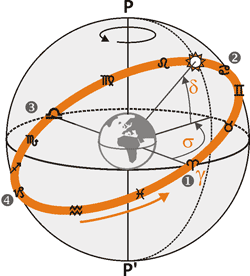
In some calendar systems the begining of the year falls on winter solstice day. In north hemisphere we get more of Sun ligthing starting from this day. Astronomers (like astrologers and gnomonists long before) preffered to start the year from spring equnoix. The moment of Sun transition from south hemisphere to north is considered to be the begining of astronomic year and usualy is defined by greek letter γ, which is very similar to Zodiac symbol of Aries - starter of the year in both astrology and gnomonics. Between solstice days certain trajectory of daily Sun's movement over the sky always happens twice a year. Spring equnoix has symmetrical day of autumn equnoix. Both equnoixes can be noticed with the help of vertical gnomon as follows:
1. Sunrise and sunset occurs in the directions, perpendicular to north-south direction. Sunrise strictly on the East, and sunset on the West.
2. The tip of the shadow moves along straight West-East line on equnoixes. During all other days the shadow of gnomon will draw a parabolic curve.
Please, do not be confused by Zodiac symbols in gnomonics. They do nothing with the real constellations in the sky, except the names. Such convinient division of the year into 12 equal parts exists since Shumer. Each Zodiac sign covers exactly 30° of annual cyrclic path of the Earth. Zodiac scheme works well even in assumtion that it is Sun, that moves around Earth together with other planets (Ptolemeus's system). Beeing observed from the Earth, Sun and all planets are moving in narrow sky corridor, called ecliptics. On the draft eliptics is marked with orange color.
... know the Earth is round and even calculate its radius!
There is a delusion concerning ideas of our ancestors about the Universe. In some schools pupils are told, that people before Maggelan and Copernic thought that the Earth is flat. The reality is that such nonsense was taught in European church schools in dark ages only. The rest of the humanity had known about the real shape of the Earth long before.
We may use vertical gnomon to determine the angle of Earth's axis in certain place. Now, we use this angle for positioning and call it latitude.
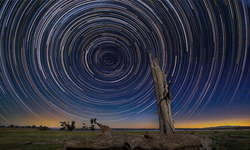
Observing the sky in clear nigth, it is possible to notice sky rotation around still point, which we call celestial pole. On the drafts this point is marked by P. Nowdays, in north hemisphere the Pole is very close to Polar star (α in Ursa Minor constellation). Linkoln Harrison, an australian photographer, is making impressive photos of night sky. You can see more of his photos here. If you decide to do such photo yourself, keep in mind that one degree rotation of the sky takes 4 minutes. So, use very long exposure and tripod (don't forget camera with BULB exposures). Good luck!
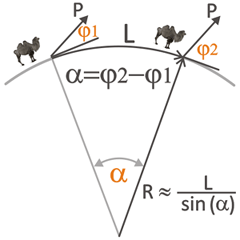
Both achient nomads and navigators needed some guides for travelling. Height of the Pole above horizont and cardinal directions gave them enough information for long trips. In open sea navigators had no landmarks and could rely only on Pole position. When moving along meridian the angle of the Pole is changing, while east-west movements don't affect the Pole position. For measuring angles on the deck of sailing boat a plumb may be very useful. All kind of sextants may be considered to be sundials too.
Most preciece Earth's measurement was made in Eqypt under supervision of Tot Trismegist. The latitude was carefully measured in Thebes (φ1) and Memphis(φ2). The way from Thebes to Memphis lays along meridian, and the distance (L) was calculated in camel's steps. The result gave only 1% of inaccuracy. Later Greeks made the same experiment, but they have used boats instead of camels and got worse result. At this point an interesting question was asked by one pupil: "how did Tot take sinus from α?". One of historical versions of sinus origin states Sanscrit etimology: sinus comes from word similar to arch, the value of sinus is angular rise of the arch above horisont. Values of sinus for different angles is what every anchient scholar was studing with gnomon. Cosinus and (arc)tangent are not needed in calculations based of table values.
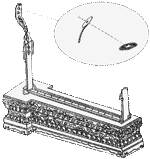
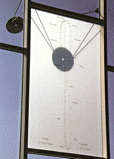
Just watching special vertical gnomon (Tugui) Chinease astronomers about 2000 years ago calculated Earth's slope as 23°43′. As you may see on the picture, a Sun light from the hole produces more accurate reading.
Finally, we can organize any timing with gnomon
Both yearnal and duarnal Sun's movement has a symmetry between culmination points. The Sun will be at the same height twice a day with equal distance from the noon. Twice a year Sun's path over the sky will be the same. Such days will be of the same distance from solstice days.
In one old Soviet film "White sun of the desert" there is a vivid moment of vertical gnomon usage by main hero, - comarade Suhov. You may have a look, if your browser supports HTML5. More interesting is the fact, that any astronaut, ever started his flight from Baikonur, has watched this movie. It is a steady tradition on Baikonur cosmodrome, established by Leonov .